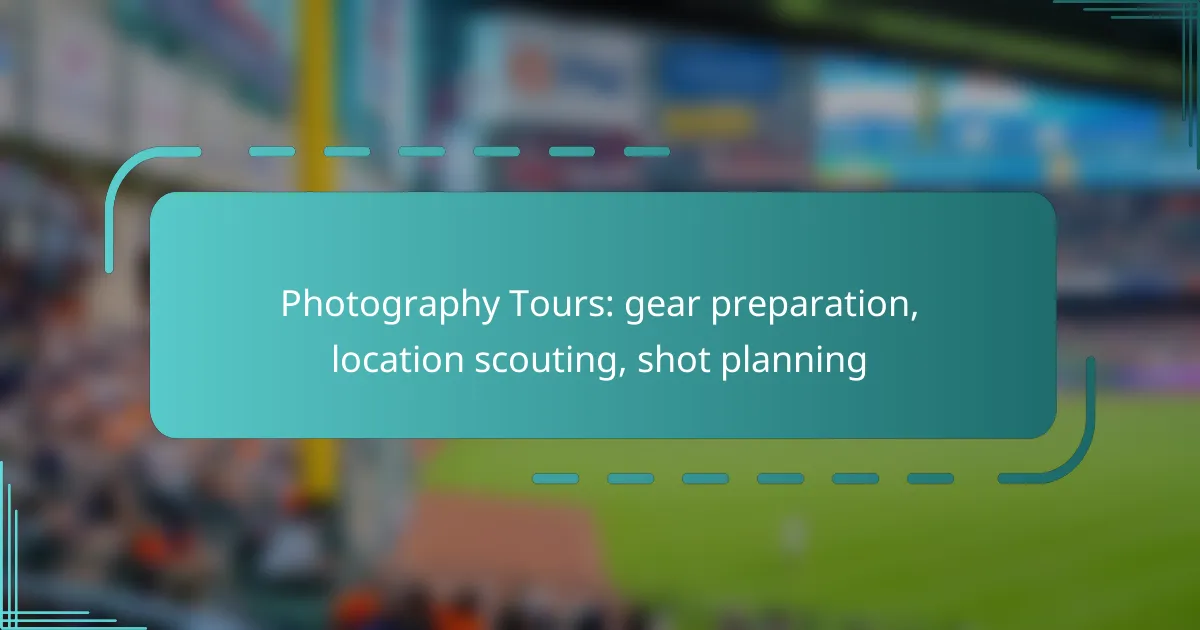Embarking on a photography tour requires meticulous preparation, starting with selecting the right gear and ensuring it is in optimal condition for capturing breathtaking images. Location scouting is equally crucial, as it allows photographers to explore potential sites, assess lighting conditions, and plan compositions that will enhance their creative vision. By combining thorough gear preparation with strategic shot planning, photographers can maximize their opportunities to capture stunning visuals during their travels.
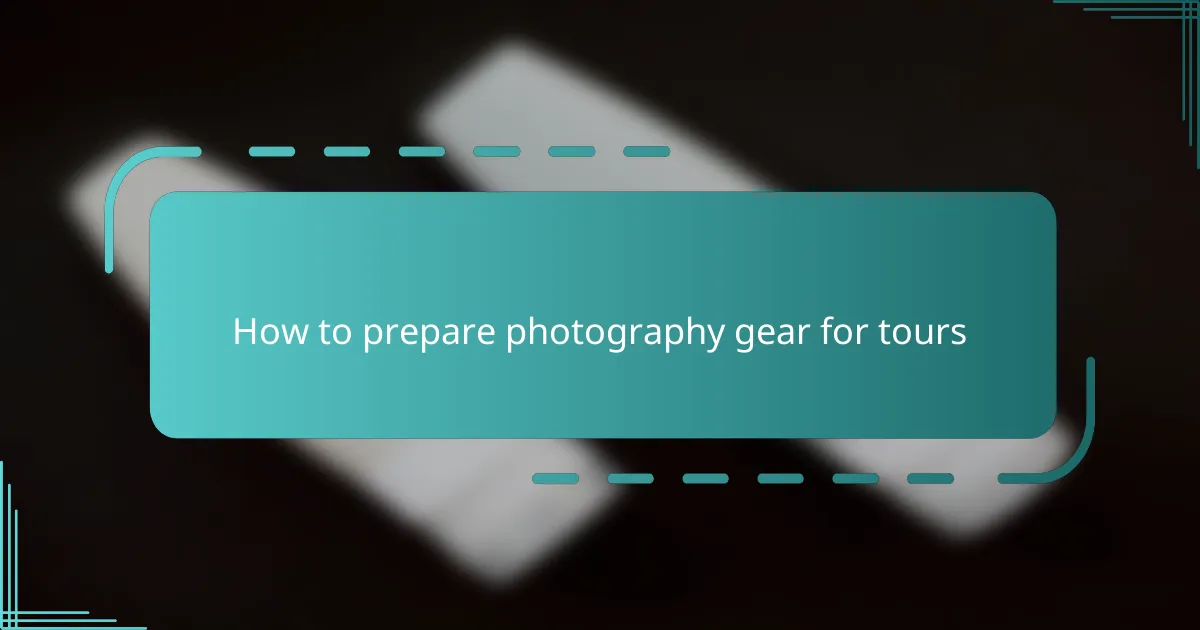
How to prepare photography gear for tours
Preparing photography gear for tours involves selecting the right equipment, ensuring everything is functional, and packing efficiently. Proper preparation enhances your ability to capture stunning images while minimizing stress during your travels.
Essential camera equipment
Your essential camera equipment should include a reliable camera body, extra batteries, and memory cards. A DSLR or mirrorless camera is ideal for versatility and image quality, while a backup camera can be beneficial in case of malfunctions.
Additionally, consider bringing a lens cleaning kit to maintain optimal image quality. Always check that your gear is in good working condition before departure to avoid issues on location.
Recommended lenses for landscape photography
For landscape photography, wide-angle lenses are highly recommended as they capture expansive scenes effectively. A lens with a focal length between 14mm and 24mm is ideal for stunning vistas.
Consider a standard zoom lens (24mm to 70mm) for versatility, allowing you to frame both wide landscapes and closer details. If you plan to shoot in low light, a lens with a larger aperture (f/2.8 or wider) can be advantageous.
Best tripods for travel photography
A lightweight, compact tripod is essential for travel photography, providing stability for long exposures and low-light conditions. Look for tripods made from aluminum or carbon fiber, which balance weight and durability.
Models that fold down to a small size and have adjustable height settings are preferable. Brands like Manfrotto and Gitzo offer reliable options that are popular among photographers.
Must-have accessories for outdoor shoots
Key accessories for outdoor shoots include a sturdy camera bag, lens filters, and a remote shutter release. A weather-resistant camera bag protects your gear from the elements while allowing easy access.
Lens filters, such as polarizers and ND filters, can enhance image quality and control light exposure. A remote shutter release helps prevent camera shake during long exposures, ensuring sharp images.
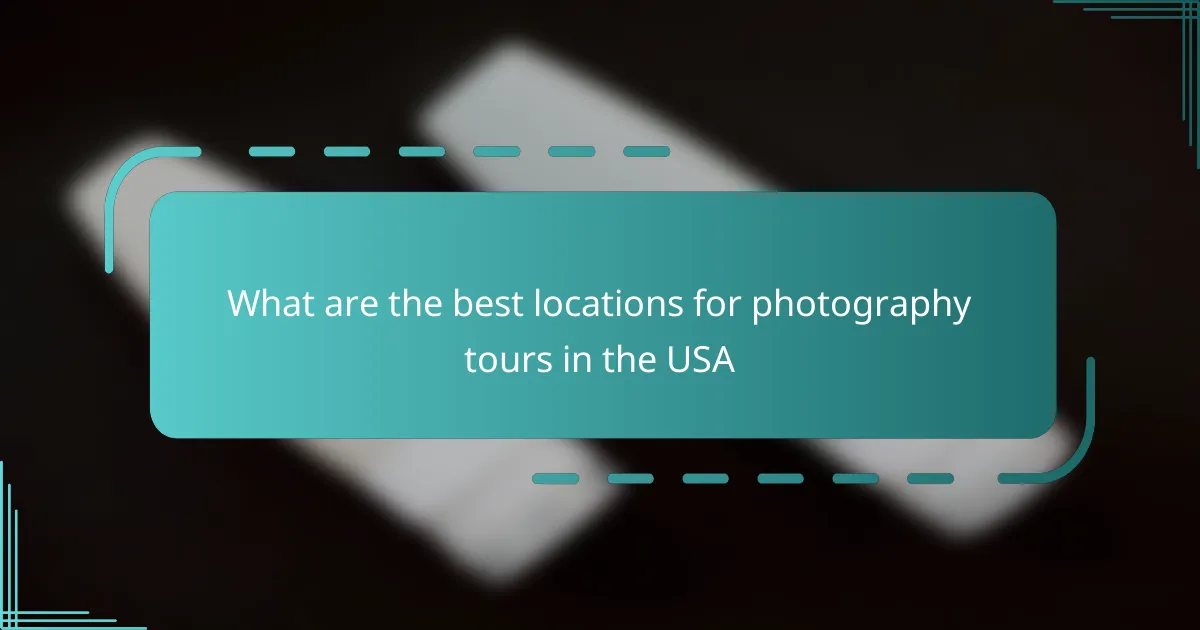
What are the best locations for photography tours in the USA
The best locations for photography tours in the USA include diverse landscapes, iconic cityscapes, and hidden gems that offer unique perspectives. These spots provide photographers with a variety of subjects, lighting conditions, and compositions to capture stunning images.
Top national parks for landscape photography
National parks are prime locations for landscape photography, showcasing breathtaking natural beauty. Parks like Yosemite, Yellowstone, and the Grand Canyon offer dramatic vistas, unique geological formations, and vibrant ecosystems.
When planning a photography tour in these parks, consider the time of year for optimal lighting and weather conditions. Early mornings and late afternoons often provide the best light, while spring and fall can enhance colors and reduce crowds.
Iconic urban photography spots
Urban environments feature iconic photography spots that capture the essence of city life. Locations such as New York City’s Times Square, San Francisco’s Golden Gate Bridge, and Chicago’s skyline are popular for their architectural beauty and dynamic street scenes.
For urban photography, timing is crucial. Shooting during the golden hour can yield stunning results, while exploring neighborhoods at different times of day can reveal unique atmospheres and activities. Be mindful of local regulations regarding photography in public spaces.
Hidden gems for unique shots
Hidden gems often provide unique photography opportunities away from the crowds. Locations like the Antelope Canyon in Arizona, the Wave in Utah, and the lesser-known waterfalls in Oregon can offer extraordinary compositions and stunning colors.
To discover these hidden spots, research online forums, photography blogs, and social media groups. Always respect the environment and follow local guidelines to preserve these locations for future photographers.

How to effectively scout locations
Effective location scouting involves researching and visiting potential sites to determine their suitability for photography. This process helps identify the best angles, lighting conditions, and compositions before the actual shoot.
Using Google Earth for location scouting
Google Earth is a powerful tool for scouting locations remotely. You can explore various terrains, view satellite imagery, and even access 3D models of landscapes, which can help you visualize potential shots.
When using Google Earth, pay attention to the terrain and surrounding features. Look for landmarks, water bodies, or unique structures that could enhance your photographs. Additionally, consider using the time-lapse feature to observe seasonal changes in the area.
Benefits of visiting locations beforehand
Visiting locations before your shoot allows you to assess the environment firsthand. You can evaluate accessibility, lighting conditions, and potential obstacles that may not be visible online.
By visiting in advance, you can also experiment with different angles and compositions, ensuring that you make the most of your time during the actual shoot. This preparation can lead to more creative and impactful images.
Tips for scouting during different times of day
Scouting at various times of day can reveal how natural light affects your chosen location. Early morning and late afternoon often provide softer, warmer light, ideal for capturing stunning landscapes.
Consider the direction of the sun and how it will illuminate your subject. For instance, shooting with the sun behind you can create vibrant colors, while backlighting can produce dramatic silhouettes. Make a note of these conditions to plan your shooting schedule effectively.

What is the importance of shot planning
Shot planning is crucial for photography tours as it helps photographers maximize their time and creativity while capturing images. By preparing in advance, photographers can ensure they capture the best possible shots, taking into account factors like lighting, composition, and location.
Creating a shot list for photography tours
A shot list is a detailed outline of the specific images a photographer aims to capture during a tour. This list should include the types of shots, locations, and any particular angles or compositions desired. Prioritizing shots based on the time of day and lighting conditions can enhance the overall quality of the images.
When creating a shot list, consider the variety of compositions you want to achieve, such as wide landscapes, close-ups, and candid moments. This variety will help you tell a more compelling story through your photography.
Understanding the golden hour for optimal lighting
The golden hour refers to the period shortly after sunrise and before sunset when the natural light is soft and warm, creating ideal conditions for photography. During this time, shadows are less harsh, and colors appear more vibrant, making it a favorite among photographers.
To make the most of the golden hour, plan your shoots around these times. Depending on your location, the golden hour can vary, so check local sunrise and sunset times to ensure you’re ready to capture the best light.
Using apps for shot planning
There are several apps available that can assist photographers in planning their shots effectively. These apps often provide features like location scouting, weather forecasts, and sun position tracking, which are essential for optimizing your photography sessions.
Popular apps include PhotoPills and The Photographer’s Ephemeris, which help you visualize the sun’s path and plan your shots accordingly. Utilizing these tools can save time and enhance the quality of your images by ensuring you are in the right place at the right time.
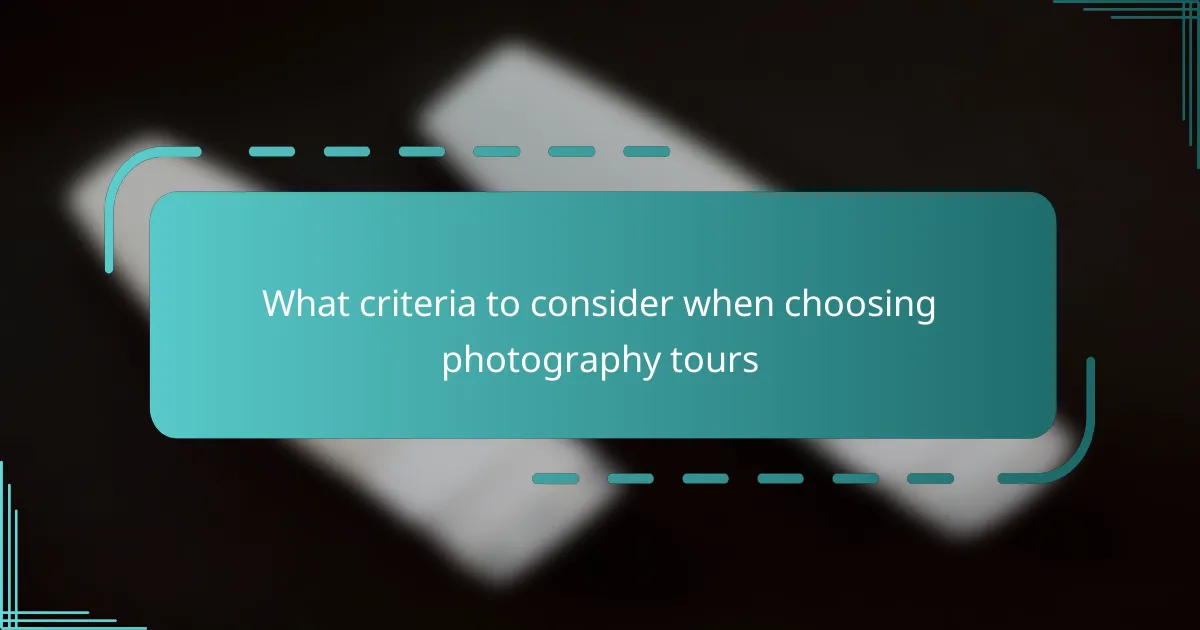
What criteria to consider when choosing photography tours
When selecting photography tours, consider the expertise of the guides, the size and dynamics of the group, and the itinerary’s structure and flexibility. These factors can significantly influence your overall experience and the quality of your photographic outcomes.
Evaluating tour guides and their expertise
Assessing the qualifications and experience of tour guides is crucial. Look for guides with a strong background in photography, including formal training or extensive practical experience in the field. Reading reviews and testimonials can provide insight into their teaching style and effectiveness.
Additionally, consider guides who are familiar with the specific locations you will be visiting. Local knowledge can enhance your experience by revealing hidden gems and optimal shooting times based on light conditions.
Assessing group size and dynamics
The size of the group can affect your ability to receive personalized attention and guidance. Smaller groups, typically ranging from 4 to 10 participants, often allow for more interaction with the guide and better opportunities for individual feedback on your photography.
Group dynamics also play a role; a supportive and enthusiastic group can enhance the experience, while a competitive or disengaged group may detract from it. Consider joining tours that emphasize collaboration and shared learning.
Understanding the itinerary and flexibility
A well-structured itinerary should balance planned activities with flexibility to adapt to changing conditions, such as weather or lighting. Look for tours that allow for spontaneous stops or adjustments based on group interests and photographic opportunities.
Review the daily schedule to ensure it includes a variety of locations and subjects, catering to different photography styles. Tours that offer both structured and free time can provide a richer experience, allowing you to explore at your own pace.
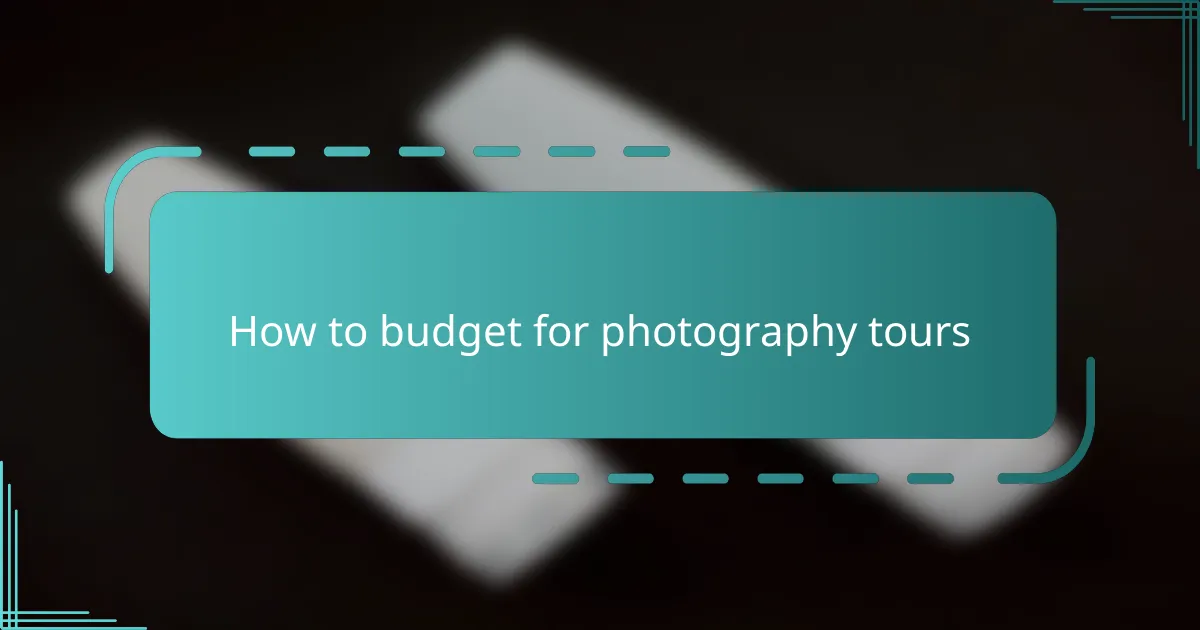
How to budget for photography tours
Budgeting for photography tours involves estimating costs for gear, travel, and tour fees. Proper planning ensures you allocate enough resources for an enriching experience without overspending.
Estimating costs for gear and travel
When estimating costs for gear, consider both your existing equipment and any additional items you may need. High-quality cameras, lenses, and accessories can range from a few hundred to several thousand dollars, depending on your requirements.
Travel expenses include transportation, accommodation, and meals. Depending on the destination, budget airlines may offer flights for low hundreds of USD, while hotels can vary widely from budget options around 50 USD per night to luxury stays exceeding 200 USD. Always factor in local transportation costs as well.
Finding affordable photography tours
To find affordable photography tours, start by researching various tour companies and comparing their offerings. Look for packages that include accommodations and meals, as these can provide better value than booking everything separately.
Consider joining group tours, which often reduce costs per participant. Additionally, check for seasonal discounts or early bird specials, which can save you a significant amount. Websites that aggregate tour options can also help you find competitive prices.
